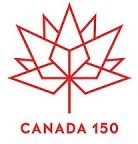129
of 150: Mentioned in Dispatches
In Canada, a Mention in Dispatches is a recognition
by a senior commander that a member of the armed forces, junior to that
commander, deserves recognition for a brave and/or meritorious act. It
is an award given by the Governor General on behalf of our monarch, as
recommended by the commander. The award may include a tangible military
honour such as a medal or bar for a medal, or it may simply be a written
acknowledgement of the member and his or her act. A Mention in Dispatches
is published in the Canada Gazette.
With this in mind, this is why the attached pamphlet published
by the Canadian Directorate of Air Training, Air Force Headquarters is
confusing. It is entitled ``Mentioned in Dispatches’’ but doesn’t fulfill
the objective of the definition outlined above. It is a collection of incidents,
for July 1943, in which RCAF airmen acted stupidly on duty with the possibility
of dire consequences for that action. Recipients in this case also, are
not personally identified, but are given the title `student,’ `instructor’
or `staff pilot’ etc.
Most confusing of all is that the Directorate of Air Training
would be allowed to satirize the otherwise sombre purpose of the 'real'
Mentioned in Dispatches. Apparently there was no objection - this pamphlet
is one of a dozen or so in the Commonwealth Air Training Plan archives
for a number of months during World War II. As incredible as this document
may be, it probably served a good purpose reminding readers of a multitude
of situations to be avoided in order to avoid personal injury or death,
and damage to equipment.
Enjoy – it is a humorous read with inside information
about the intricacies of involvement with the British Commonwealth Air
Training Plan.
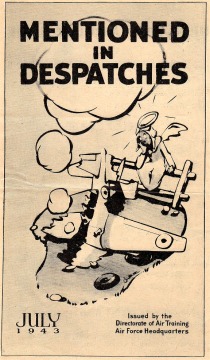 .
.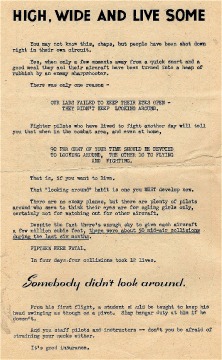 .
.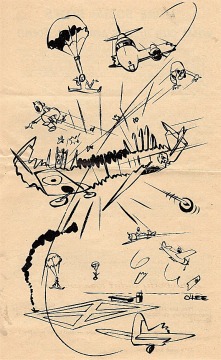 .
.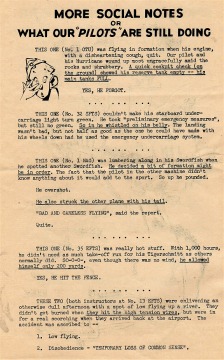 .
.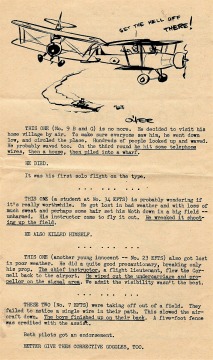 .
. 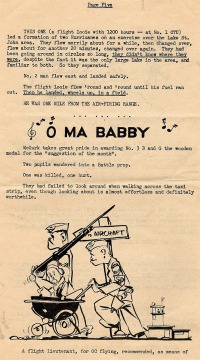
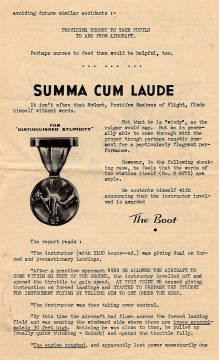 .
.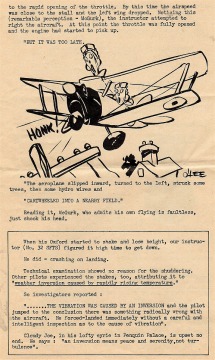 .
.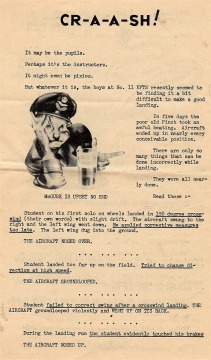 .
.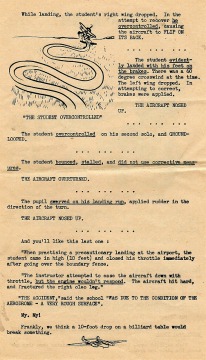 ..
..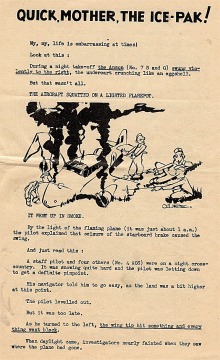 .
.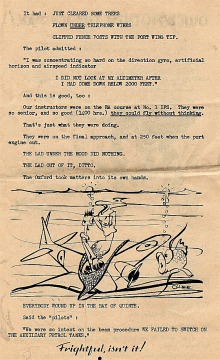
130
of 150: A World War II Memory - Cy Roberts, Flying Instructor
In this Oral History, Cy Roberts
submitted his recollections of three training incidents that occurred at
No. 12 Service Flying Training School where he was a Royal Canadian Air
Force instructor for the British Commonwealth Air Training Plan.
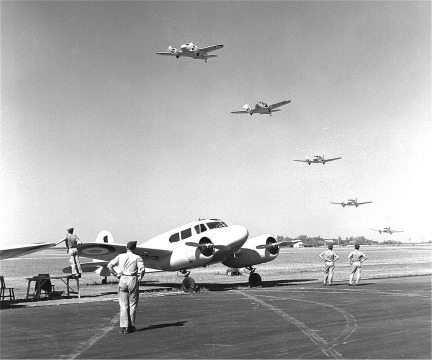
A flight of Cessna Cranes flyover at opening day at
No. 12 Service Flying Training School, Brandon, Manitoba – DND photo.
Commonwealth Air Training Plan Museum
Brandon Manitoba
Gentlemen (and Ladies)
The attached is submitted at the persistent and honorable
request of the McNabb family of Minnedosa (Manitoba)! They are very much
on your team – if not in fact – very much in spirit – and have been pressing
for a contribution of some experiences occurring in the training
of pilots at #12 (Service Flying Training School). The writer was fresh
from F.I.S. (Flight Instructor School) to #12 December 12, 1942. He was
to remain there exactly 2 years and one week – thereon being posted to
Macdonald (No. 3 Bombing & Gunnery School) – as an instructor. He was
to be involved with New Zealanders - Aussies – Canadians – some Brits –
the lot – and as you can imagine – lots of different situations.
Your correspondent is C.M. Roberts, Toronto, Ontario.
Contact! – No. 1
"Who's got the reins?
This (now) old instructor had nearly finished his course
at #2 F.I.S. Vulcan,
Alberta. He doesn't know it yet- but shortly he'd be
reporting to #12 S.F.T.S. F.I.S. has done a good job - taught their new
instructors the correct and thorough way to teach their students. i.e.
demonstrates, then explains precisely. The explanation is called PATTER.
PATTER practice is obtained by flying with a classmate - and carefully
instructing each other!
In this particular case - he's in the front seat of a
Cornell - hands folded – enjoying the day. He's had a good hour of practice
- weather is beautiful - and they're going home!
Then gently - the aircraft dips to starboard - gently
drops 4,500 feet – and gently rises to just about the original height -
then if that isn't enough – it gently dips to port - drops another 4,500
feet and back where we started. It seemed ready to repeat again when this
instructor says to his rear seat friend: "What the HECK are you doing?"
He gets a straight rather annoyed answer: "What do you
mean - what am I doing?" "Aren't you flying this?"
"No aren't you?"
"No!"- We'd been pilotless!!!
Note: When you hand over control say loudly "You are in
control"! The response is "I have control" It can head off a lot of problems.
WHEN REQUIRED ALL MY STUDENTS HEARD THAT STORY.
Contact! – No. 2
What's a little Ice?
P/0 Roberts just posted to #12- reports to A flight Dec 1/42.
Flight commander is FO Kjellander - an able individual who is a good friend
to this day. Roberts is now ready for duty.
Later in the day "Sky" Kjellander directs him to take
a Crane to Chater (our relief field) about 10 minutes air time away - two
of our students have had their a/c (aircraft) go US (unserviceable?).
Shortly, he's there and picks up New Zealanders Adolph
and Sherrif (thank- you log book). Then airborne, and about five minutes
later, their windscreen is suddenly coated with ice - totally! They have
NO forward vision. Icing this severe can be bad news. The ice itself adds
weight to the a/c and building up on the wing can actually change its shape
and effectiveness.
The instructor knows he has to get down as soon as possible,
he's peering out his side window with his students peering out theirs -
he's careful to keep his sped 10-15 miles higher - and shortly notes the
boundaries of #12 - he's 20-30' feet higher than normal - then suddenly
WHAM! The alc just stopped flying and dropped heavily onto a gravel strip
short of the paved runway. They're down and please to be in one piece!
Interesting note re: icing. Teaching the subject must
come first in ground school and secondly of course from the flying instructor.
When icing conditions do prevail at or near the station- the 0/C
(officer in charge?) flying, using his own judgement plus consultation
with his MET (meteorological) man - must either wash-out flying immediately
- or specify dual only. Sometimes a critical, difficult but urgent decision.
In our case, seeing some other ice signs, and witnessing
our difficulty flying was washed out immediately.
(Handwritten note – in flying at #12 for a couple of more
years, we would experience other icing – but never again as sudden – or
so heavy! C.R.)
Contact! – No. 3
Follow the Leader!
Part and parcel of earning your wings at SFTS is training
in night flying. When a student is ready for the night phase - he'll fly
a number of night circuits with his instructor - then when considered ready,
he'll be sent for several nights to fly these circuits solo. Confidence
rising he'll then be slotted for a couple of night x-countries with his
instructor.
At this point in our story a new instructor has just been
posted to #12 and assigned to "E" flight. After a few days getting acclimatized
he is scheduled to take one of his four students on a 3-hour night x-country.
It was at this point he asked his flight commander (self) if he could follow
the F/C's aircraft for this trip.
As the territory was completely new to our new man, we
agreed - instructing him to meet us at 6000 feet directly over the
airport. He was to flash his lights for identification - and we would respond
likewise.
He did - and we did - and we're off leading the way.
The trip itself was uneventful - weather good - and about 3 hours later
we're home. Our course had been triangular – Brandon - southeast then northeast
- then home on the final leg.
Anxious to hear how our new man had gotten along, we waited
for his return in the flight room - and waited - and waited! After another
half-hour we advised our station of our concern - then after another half-hour
we alerted Command – our alc was missing!
Ten or fifteen minutes after that call - we received a
call ourselves. It was our new instructor. Conversation went like this:
Self " Man we're glad to hear your voice"
He "We're OK"
Self " Well where are your?"
He "We're in the States"
Self "in shock - in the States?" (couple of minutes later
but barely composed- "How come you didn't follow us?’’
He "Well when you responded to our light flashing over
the airport YOU LEFT your lights OFF - and we soon lost you’’
Later when he realized he was "good and lost" - he fired
a flare from his a/c and saw what seemed to be a fairly flat, cropped
farm field - it proved to be very, very fortunately adequate when one considers
the soft spots and invisible holes that might have caught him.
You think that's the end- Wrong! It took about 3 days
to get our new man, his student and the aircraft back to #12. During that
time he had stayed with his aircraft, as he should - then when word got
around the rural community, that a Canadian aircraft had made a forced
landing at night in a local field - he and his student became celebrities!
Possessed of good looks and a good personality he proved
to be an excellent ambassador. The kindly farm folk brought meals for both
of them. The US government folks however, while co-operative and friendly
took a poor view of foreign aircraft's "sneaking" into their country
at night. They had strong objections at a similar event in daytime - but
there's something sinister when this takes place at night.
Our "new instructor" and his student came back with a
lot of stories - the main one however, was of a trip they'll never forget.
Neither will their Flight Commander!
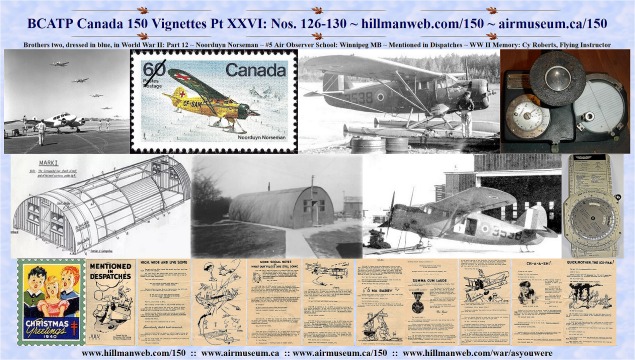
Click for full-size preview collage

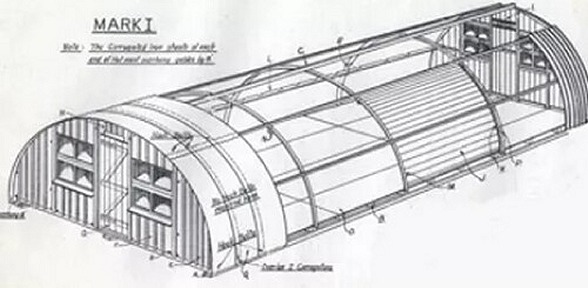
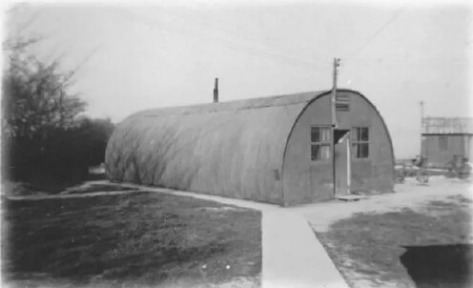
 During
the fall of '43 the CBC or NFB, I don't recall which, sent a film crew
and reporters to stage a "Xmas Dinner" at a Bomber base: I think about
40 of us were invited, 20 aircrew and 20 groundcrew. We were chosen on
the basis of squadron seniority and a lot of "Rank" felt rank about the
whole thing. It was held at the Legion in Gransden Lodge. The food was
the best and drinks flowed freely.
During
the fall of '43 the CBC or NFB, I don't recall which, sent a film crew
and reporters to stage a "Xmas Dinner" at a Bomber base: I think about
40 of us were invited, 20 aircrew and 20 groundcrew. We were chosen on
the basis of squadron seniority and a lot of "Rank" felt rank about the
whole thing. It was held at the Legion in Gransden Lodge. The food was
the best and drinks flowed freely.
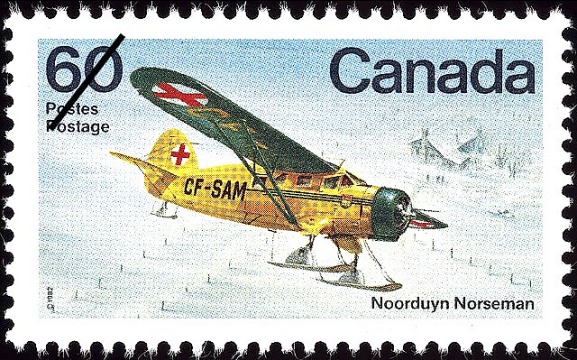
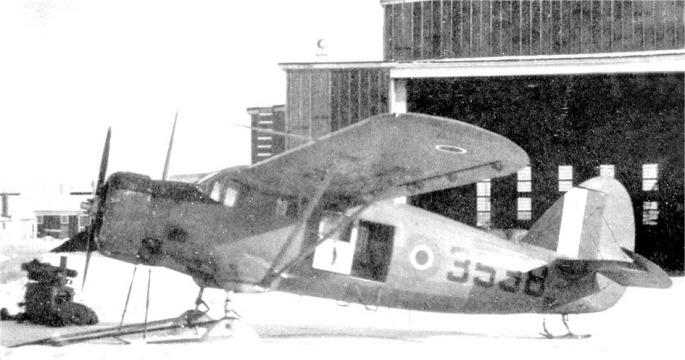
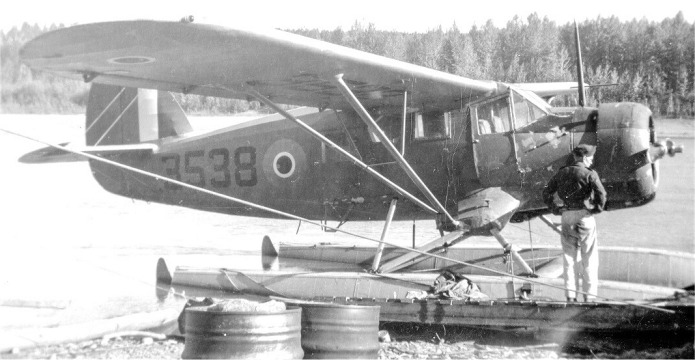
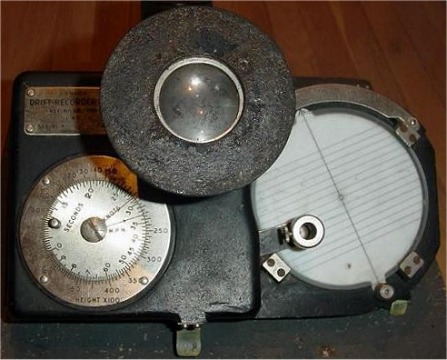
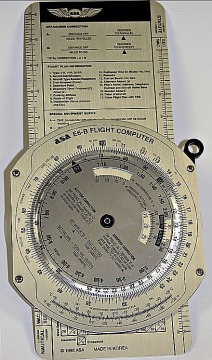
 .
. .
. .
. .
. .
. 
 .
. .
. .
. ..
.. .
.


